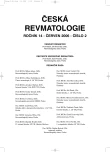-
Medical journals
- Career
Immunolocalization of 3-nitrotyrosine in human synovium
Authors: J. Niederlová 1; D. Kodetová 2; O. Kryštůfková 1; V. Vilím 1
Authors‘ workplace: Revmatologický ústav, Praha 1; Ústav patologie a molekulární medicíny UK 2. LF a FN Motol, Praha 2
Published in: Čes. Revmatol., 14, 2006, No. 2, p. 49-52.
Category: Original Papers
Overview
3-nitrotyrosine (3NT) is regarded as some kind of a „footprint“ of NO generation. Immunohistochemical
analysis was performed on 9 specimens of human synovium (3 rheumatoid arthritis, 4 osteoarthritis (OA), 1 juvenile idiopathic arthritis, and 1 inflamed Baker’s cyst derived from a joint of a patient with villonodular synovitis). Serial sections were stained with monoclonal antibody 60-E3 to 3NT, and with antibodies to CD31, CD68, and CD14 reacting to endothelial cells, macrophages and monocytes, respectively. The majority of specimens demonstrated a pattern of strong 3NT staining localized to endothelial cells accompanied by weak immunostaining of tissues closely surrounding the 3NT-positive endothelia (7 of the 9 specimens, including all of the specimens derived from osteoarthritic joints). We observed strong 3NT immunostaining of synovial stroma in only 2 specimens of inflamed synovia, those collected from the Baker’s cyst secondary to villonodular synovitis and a knee joint with rheumatoid arthritis. We conclude that in human synovial tissue, tyrosine is primarily nitrated in endothelial cells. 3NT-positive staining of endothelial cells in OA synovia suggests that activation of endothelial cells occurs even in apparently non-inflammatory OA synovial tissue.Key words:
nitric oxide, nitrotyrosine, synovium, osteoarthritis, immunohistochemistry
Labels
Dermatology & STDs Paediatric rheumatology Rheumatology
Article was published inCzech Rheumatology

2006 Issue 2-
All articles in this issue
- Immunolocalization of 3-nitrotyrosine in human synovium
- The role of osteoprotegerin in diffuse idiopathic skeletal hyperostosis and ankylosing spondylitis
- The role of synovial fibroblasts in the pathogenesis of rheumatoid arthritis
- Complex morphological examination of patients with ankylosing spondylitis
- The role of vitamin D in prevention and therapy of glucocorticoid-/inflammation-induced osteoporosis
- Osteoporosis in some inflammatory rheumatic diseases
- Czech Rheumatology
- Journal archive
- Current issue
- Online only
- About the journal
Most read in this issue- Osteoporosis in some inflammatory rheumatic diseases
- Complex morphological examination of patients with ankylosing spondylitis
- The role of synovial fibroblasts in the pathogenesis of rheumatoid arthritis
- The role of vitamin D in prevention and therapy of glucocorticoid-/inflammation-induced osteoporosis
Login#ADS_BOTTOM_SCRIPTS#Forgotten passwordEnter the email address that you registered with. We will send you instructions on how to set a new password.
- Career

